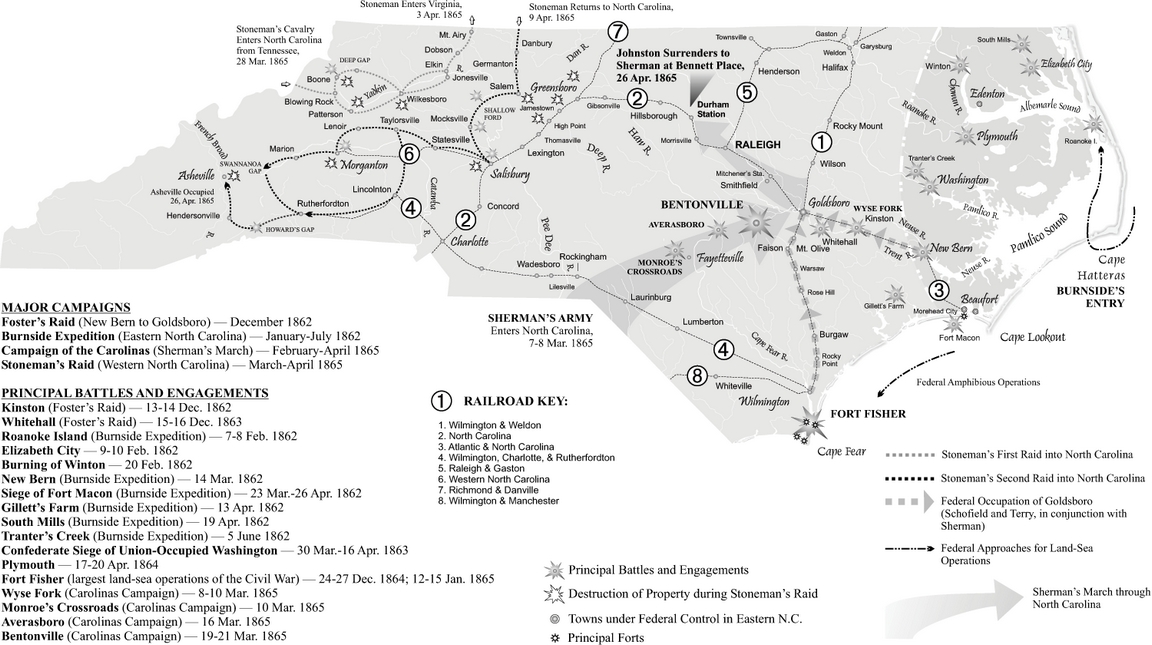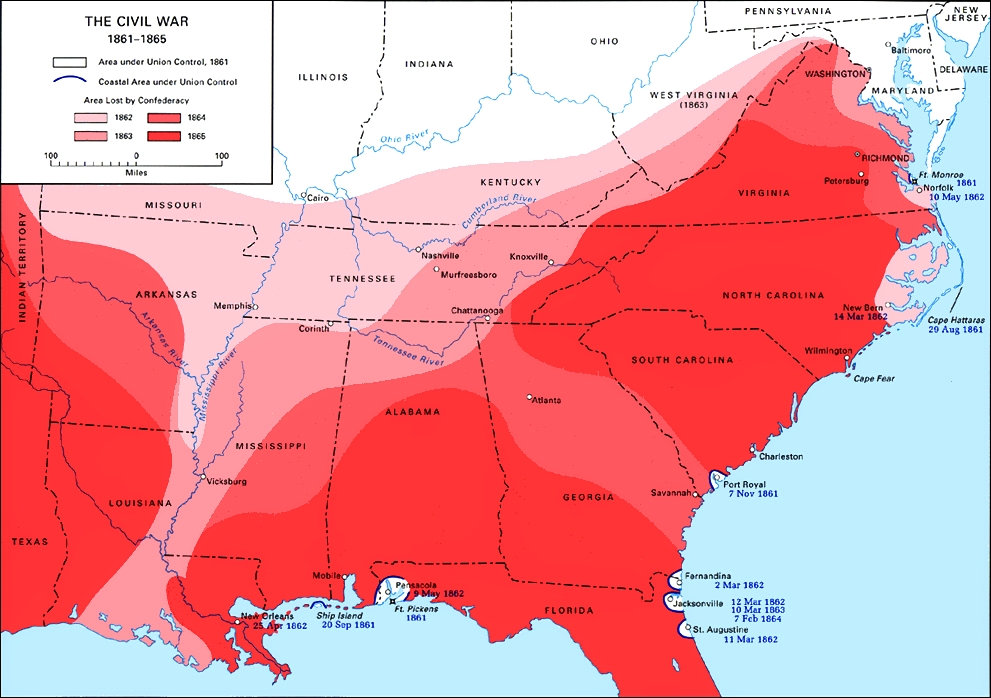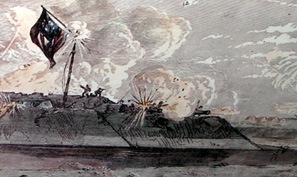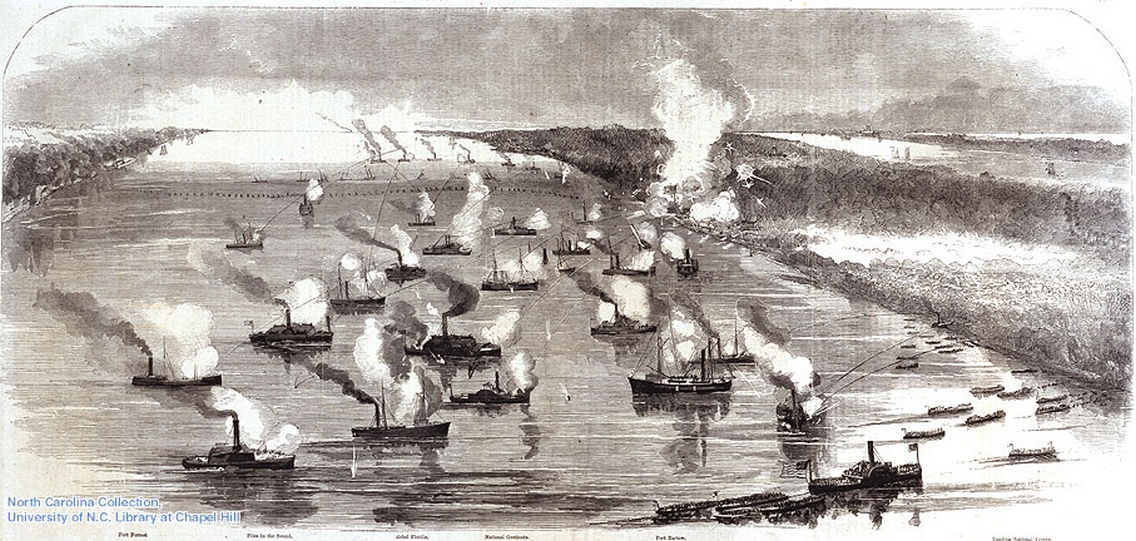|
North Carolina and the Confederate States Navy
| North Carolina Navy and Confederate Navy |

|
| North Carolina Coast was the scene of several naval engagements during the Civil War |
North Carolina Navy
Students of the Civil War often overlook the contributions of the naval
services in the conflict. The Confederate Navy and Marine Corps, however, played significant roles in North Carolina.
They not only hampered the ability of the Union Navy to do its job, but took part in some of the state’s largest battles.
Genesis of the Confederate
Navy
At Montgomery, Alabama, the Confederate Congress created a Navy Department
in February 1861. Stephen R. Mallory of Florida was selected by President Jefferson Davis to lead the department and
was confirmed by Congress on May 5. Mallory appeared capable of leading the new navy due to his service on the U.S.
Senate Naval Affairs Committee prior to secession. The newly created navy absorbed the state navies of South Carolina,
Florida, Louisiana, Texas, Alabama, Virginia, and North Carolina. These state navies, however, only consisted of about
a dozen small ships, mounting few guns. By war’s end the Confederate Navy managed to put 130 ships into service--a
far cry from the 670-vessel US Navy. The disparate numbers should not be considered a failure on Mallory’s part,
however, for he performed as well as could be expected considering the circumstances; a lack of government interest and funding
throughout the war hampered Mallory’s efforts.
The Confederate Navy’s mission was three-fold. First, it
was to provide coastal defense and protection for inland waterways. Second, its ironclad construction program was designed
to break the Union blockade of the southern coast. Third, it was seen as a function of the navy to raid enemy commerce.
Today, students of the Civil War remember the Confederate Navy primarily because of the exploits of the CSS Alabama and CSS
Shenandoah. Two North Carolinians commanded Confederate cruisers: James I. Waddell (CSS Shenandoah) and John N. Maffitt
(CSS Florida). While the Confederate Navy was moderately successful at commerce raiding, it never provided an adequate
coastal defense or broke the Union blockade.
The Confederate Navy and Marine Corps played a significant role in North
Carolina because much of the war in the state involved coastal operations. Early in the war, North Carolina contributed
what was nicknamed the “Mosquito Fleet,” a small force of lightly armed vessels, to the Confederate cause.
During the 1862 Burnside Expedition in coastal North Carolina, these ships participated in the Battle of Roanoke Island, and
all but the CSS Beaufort were subsequently destroyed during the Battle of Elizabeth City. These battles ended what little
threat the fleet posed to the Union forces.
North Carolina Ironclads
Of six ironclads begun in North Carolina, four were commissioned.
| North Carolina Civil War Navy History |

|
| Map of Union Navy Strategy for the North Carolina Coast |
| North Carolina Civil War Navy History |

|
| Union Naval Bombardment of Fort Hatteras |
The Confederate government attempted building ironclads in the state, and was successful in completing four ships: the CSS North Carolina and the CSS Raleigh on the Cape Fear River, the CSS Albemarle on the Roanoke River, and the CSS Neuse on the Neuse River. There
were also naval yards and stations located across the state, including a large operation at Charlotte for manufacturing
marine machinery and other facilities in Wilmington, Halifax, Kinston, and for a brief time in Tarboro.
Aside from the Burnside Expedition, the Confederate Navy and Marine Corps
conducted numerous operations throughout coastal North Carolina. In early February 1864, Commander John Taylor Wood
led a detachment of thirty-three officers and 220 enlisted sailors and Marines downriver from Kinston to New Bern, where they
boarded, captured, and destroyed the USS Underwriter in one of the most daring missions of the Civil War.
The Kinston-built ironclad, CSS Neuse, was completed shortly after Wood’s
expedition to New Bern. Confederates hoped that the ironclad might help recapture the old colonial capital. On
its voyage downriver, the Neuse ran aground in a shallow portion of the river and was not freed until a month later.
By then, all operations in eastern North Carolina had ceased because army units had been recalled to Virginia to assist in
the defense of Richmond. The Neuse waited ten months to be called into service--this time to cover the evacuation of
Kinston following the Battle of Wyse Fork in March 1865. The ironclad was taken downriver. Its cannons bombarded
the Union Army while Confederate troops abandoned the town. Once the evacuation was complete, the Neuse was scuttled
to prevent capture.
In mid-April 1864, the ironclad CSS Albemarle, captained by Commander James
W. Cooke, helped Confederate forces recapture the town of Plymouth. The Albemarle rammed and sank the USS Southfield
and successfully battled the USS Miami which lost its captain, Lieutenant Commander Charles Flusser in the fight.
In early May 1864, the Albemarle steamed for New Bern to help retake the city from Union occupation forces. Not
very long after departing Plymouth, the Albemarle and two smaller ships, the CSS Bombshell and CSS Cotton Plant engaged seven
Union warships as they entered the waters of the Albemarle Sound. The ensuing battle was fierce, with the Union vessels
firing over 600 shots. A riddled smokestack was the Albemarle’s most significant damage. The loss of the
ship’s smokestack and the use of inferior coal caused a loss of draft, making the ship nearly inoperable. Without
significant draft, the engines did not have enough steam to operate properly, so Cooke was forced to return to Plymouth.
In the end, the most successful North Carolina ironclad, the Albemarle, was sunk on October 27, 1864, by a spar torpedo at
her moorings by a Union Navy commando raid.
Approximately at the same time the CSS Albemarle battled the Union fleet
in the Albemarle Sound, the CSS Raleigh undertook the only offensive action of the war by the Confederate Navy at Wilmington.
At nightfall on May 6, 1864 the Raleigh escorted a number of blockade runners across the New Inlet bar near Fort Fisher and
attacked Union ships on blockade. These targeted attacks continued throughout the night, and nearing daybreak on May
7, the ironclad came back into New Inlet and under the protection of the fort. On its return trip upriver to Wilmington,
the Raleigh grounded on a sandbar. Before the gunboat could be freed, its keel broke and the Raleigh sank. The other
Wilmington ironclad, the CSS North Carolina, never equipped with adequate engines, sank at its moorings in September 1864;
marine worms had infested the hull.
| North Carolina Navy and the Civil War |

|
| North Carolina and Union Naval Duel |
(About) The naval fight in Croatan Sound and the landing of Union troops.
Union naval bombardment of Roanoke Island, NC, on Feb. 7, 1862, and Confederate mosquito fleet, in background, consisting
of seven gunboats, was quickly displaced by the Union navy, and on Feb. 8 Union soldiers arrived on the island by an amphibious
assault that had circumnavigated the obstructions in the Sound. After a brief fight, Roanoke Island was surrendered
to avoid additional bloodshed by the Confederates. Courtesy North Carolina Civil War Image Portfolio, UNC University
Libraries.
Fort Fisher
The Confederate Navy and Marine Corps had significant involvement in the
two battles at Fort Fisher and the Wilmington Campaign. The Submarine Battery Service was instrumental in placing electrically
detonated torpedoes in the waters of the Cape Fear to deter Union blockaders from attempting to enter the river. The
battery was also stationed at Fort Anderson to operate torpedoes in the river after the fall of Fort Fisher.
Battery Buchanan, detached from Fort Fisher, was built as a response to
the ineffectiveness and loss of the CSS North Carolina and CSS Raleigh. It was commanded and manned entirely by naval
personnel and armed with two seven-inch Brooke rifles and two eleven-inch Brooke smoothbore guns, all considered to be “naval”
ordnance. The battery was commanded by Lieutenant Robert F. Chapman. A twenty-nine-man detachment from the raider
CSS Chickamauga, under the command of Lieutenant Francis M. Roby, manned another battery of seven-inch Brooke rifles in another
part of the fort. During the First Battle of Fort Fisher on December 24-25, 1864, both Brooke rifles, manned by Lt.
Roby’s men, burst and injured nearly half the detachment and put the battery out of service.
Following the First Battle of Fort Fisher, fifty-one officers and men of
the defunct Savannah Squadron (including nine African American sailors) arrived at Wilmington to reinforce the naval battery
at Fort Fisher. The Second Battle of Fort Fisher was fought from January 13-15, 1865. Late in the battle, knowing
that the fort was lost, Lt. Chapman abandoned his position, and his men escaped across the river. Sailors then temporarily
manned Batteries Meares and Campbell on the west bank of the river but soon resumed retreating toward Wilmington as the Union
forces pushed toward the town. All vessels, records, drawings, and buildings at the shipyards were destroyed while the
navy evacuated Wilmington ahead of the Union army.
Conclusion
Throughout the war, the Confederate Navy and Marine Corps did their best
to help protect the coast and rivers of eastern North Carolina. Though not always successful, the naval forces were
almost always a factor in any action. The inadequate naval yards of the state managed to produce four ironclad gunboats
as well as marine machinery and desperately needed parts. Native North Carolinians served in many capacities, from common
sailors and blockade-runner pilots to cruiser captains, and contributed greatly to the war effort. The problems in North
Carolina, however, revealed a much larger problem: the Confederate Navy never had enough resources, manpower, or time
to accomplish strategic goals.
(Sources and related reading below.)
Recommended
Reading: A History of the Confederate Navy
(Hardcover). From Publishers Weekly: One of the most prominent European scholars of the Civil War weighs in with a provocative
revisionist study of the Confederacy's naval policies. For 27 years, University of Genoa history professor Luraghi (The Rise
and Fall of the Plantation South) explored archival and monographic sources on both sides of the Atlantic to develop a convincing
argument that the deadliest maritime threat to the South was not, as commonly thought, the Union's blockade but the North's
amphibious and river operations. Confederate Navy Secretary Stephen Mallory, the author shows, thus focused on protecting
the Confederacy's inland waterways and controlling the harbors vital for military imports. Continued below…
As a result,
from Vicksburg
to Savannah to Richmond, major
Confederate ports ultimately were captured from the land and not from the sea, despite the North's overwhelming naval strength.
Luraghi highlights the South's ingenuity in inventing and employing new technologies: the ironclad, the submarine, the torpedo.
He establishes, however, that these innovations were the brainchildren of only a few men, whose work, although brilliant,
couldn't match the resources and might of a major industrial power like the Union. Nor did
the Confederate Navy, weakened through Mallory's administrative inefficiency, compensate with an effective command system.
Enhanced by a translation that retains the verve of the original, Luraghi's study is a notable addition to Civil War maritime
history. Includes numerous photos.
Recommended Reading: Storm over Carolina: The Confederate
Navy's Struggle for Eastern North Carolina. Description: The struggle for control of the eastern waters of North Carolina during the War Between the States was a bitter, painful,
and sometimes humiliating one for the Confederate navy. No better example exists of the classic adage, "Too little, too late." Burdened
by the lack of adequate warships, construction facilities, and even ammunition, the South's naval arm fought bravely and even
recklessly to stem the tide of the Federal invasion of North Carolina from the raging Atlantic. Storm Over Carolina is the account of the
Southern navy's struggle in North Carolina waters and it
is a saga of crushing defeats interspersed with moments of brilliant and even spectacular victories. It is also the story
of dogged Southern determination and incredible perseverance in the face of overwhelming odds. Continued below...
For most of
the Civil War, the navigable portions of the Roanoke, Tar, Neuse, Chowan, and Pasquotank rivers were
occupied by Federal forces. The Albemarle and Pamlico sounds, as well as most of the coastal towns and counties, were also
under Union control. With the building of the river ironclads, the Confederate navy at last could strike a telling blow against
the invaders, but they were slowly overtaken by events elsewhere. With the war grinding to a close, the last Confederate vessel
in North Carolina waters was destroyed. William T. Sherman
was approaching from the south, Wilmington was lost, and the
Confederacy reeled as if from a mortal blow. For the Confederate navy, and even more so for the besieged citizens of eastern
North Carolina, these were stormy days indeed. Storm Over Carolina describes their story, their struggle, their history.
Recommended Reading: Ironclads and Columbiads: The Coast
(The Civil War in North Carolina) (456 pages). Description: Ironclads and Columbiads covers some of the most
important battles and campaigns in the state. In January 1862, Union forces began in earnest to occupy crucial points on the
North Carolina coast. Within six months, Union army and
naval forces effectively controlled coastal North Carolina from the Virginia
line south to present-day Morehead City.
Union setbacks in Virginia, however, led to the withdrawal of many federal soldiers from North Carolina, leaving only enough
Union troops to hold a few coastal strongholds—the vital ports and railroad junctions. The South during the Civil War,
moreover, hotly contested the North’s ability to maintain its grip on these key coastal strongholds.
Recommended Reading: The Civil War in the Carolinas
(Hardcover). Description: Dan Morrill relates the experience
of two quite different states bound together in the defense of the Confederacy, using letters, diaries, memoirs, and reports.
He shows how the innovative operations of the Union army and navy along the coast and
in the bays and rivers of the Carolinas affected the general course of the war as well as
the daily lives of all Carolinians. He demonstrates the "total war" for North
Carolina's vital coastal railroads and ports. In the latter part of the war, he describes
how Sherman's operation cut out the heart of the last stronghold
of the South. Continued below...
The author
offers fascinating sketches of major and minor personalities, including the new president and state governors, Generals Lee,
Beauregard, Pickett, Sherman, D.H. Hill, and Joseph E. Johnston. Rebels and abolitionists, pacifists and unionists, slaves
and freed men and women, all influential, all placed in their context with clear-eyed precision. If he were wielding a needle
instead of a pen, his tapestry would offer us a complete picture of a people at war. Midwest Book Review: The Civil War in the Carolinas by civil war expert and historian
Dan Morrill (History Department, University of North Carolina at Charlotte, and Director of the Charlotte-Mecklenburg Historical
Society) is a dramatically presented and extensively researched survey and analysis of the impact the American Civil War had
upon the states of North Carolina and South Carolina, and the people who called these states their home. A meticulous, scholarly,
and thoroughly engaging examination of the details of history and the sweeping change that the war wrought for everyone, The
Civil War In The Carolinas is a welcome and informative addition to American Civil War Studies reference collections.
Recommended
Reading: Last Flag Down: The Epic Journey of the Last Confederate Warship. From Publishers Weekly: Thriller writer Baldwin (The Eleventh Plague et al.) joins forces
with the prolific Powers (coauthor of Flags of Our Fathers et al.) to come up with a fast-reading Civil War true adventure
saga centered a on young CSA navy lieutenant. The 24-year-old Conway Whittle, an ancestor of Baldwin's,
was assigned as first lieutenant and executive officer on the Confederate raider Shenandoah late in the war. The ship sailed
from London disguised as a merchant vessel and underwent a
memorable cruise round the globe, attacking and destroying Yankee merchant ships and whalers. Whittle and company kept up
their daring sea raids until August of 1865, when they learned that the war had ended five months earlier. The ship returned
to England, having flown the last Confederate
flag at sea in defiance of the U.S. Baldwin and Powers recount their tale in a lively, evocative style and may be forgiven
for being overly fond of their hero. Whittle, they say, "was as good a man as history seems able to produce: a warrior of
courage inconceivable to most people; a naval officer of surpassing calm and intelligence; a seeker after Christian redemption;
a steadfast lover; a student of human nature; a gentle soul; a custodian of virtue."
Recommended
Reading: The Rebel Raiders: The Astonishing History of the Confederacy's Secret Navy (American Civil War). From Booklist: DeKay's modest monograph pulls together
four separate stories from the naval aspects of the American Civil War. All have been told before but never integrated as
they are here. The first story is that of James Bulloch, the Confederate agent who carefully and capably set out to have Confederate
commerce raiders built in neutral England.
The second is that of the anti-American attitudes of British politicians, far more extreme than conventional histories let
on, and U.S. Ambassador Charles Francis Adams' heroic fight against them. The third is a thoroughly readable narrative of
the raider Alabama and her capable, quirky captain, Raphael
Semmes. The final story is about the Alabama claims--suits for damages done to the U.S. merchant marine by Confederate raiders, which became
the first successful case of international arbitration. Sound and remarkably free of fury, DeKay's commendable effort nicely
expands coverage of the naval aspects of the Civil War.
Recommended
Reading: Naval Campaigns of the Civil War.
Description: This analysis of naval engagements during the War Between the States presents the action from the efforts at
Fort Sumter during the secession of South Carolina in 1860, through the battles in the Gulf of Mexico, on the Mississippi
River, and along the eastern seaboard, to the final attack at Fort Fisher on the coast of North Carolina in January 1865.
This work provides an understanding of the maritime problems facing both sides at the beginning of the war, their efforts
to overcome these problems, and their attempts, both triumphant and tragic, to control the waterways of the South. The Union
blockade, Confederate privateers and commerce raiders are discussed, as is the famous battle between the Monitor and the Merrimack. Continued below…
An overview
of the events in the early months preceding the outbreak of the war is presented. The chronological arrangement of the campaigns
allows for ready reference regarding a single event or an entire series of campaigns. Maps and an index are also included.
About the Author: Paul Calore, a graduate of Johnson and Wales University,
was the Operations Branch Chief with the Defense Logistics Agency of the Department of Defense before retiring. He is a supporting
member of the U.S. Civil War Center and the Civil War Preservation Trust and has also written Land Campaigns of the Civil
War (2000). He lives in Seekonk, Massachusetts.
Sources: Leslie S. Bright, William H. Rowland, and James C. Bardon, CSS
Neuse: A Question of Iron and Time (Raleigh, 1981); R. Thomas Campbell, Storm Over Carolina: The Confederate Navy’s
Struggle for Eastern North Carolina (Nashville, 2005); Richard G. Elliott, Ironclad of the Roanoke: Gilbert Elliott’s
Albemarle (Shippensburg, 2005); Chris E. Fonvielle, Jr., Last Rays of Departing Hope: The Wilmington Campaign (Campbell, CA,
1997); Rod Gragg, Confederate Goliath: The Battle of Fort Fisher (New York, 1991); Richard A. Sauers, The Burnside Expedition
in North Carolina: A Succession of Honorable Victories (Dayton, 1996); William N. Still, Jr., The Confederate Navy: The Ships,
Men and Organization, 1861-65 (Annapolis, 1998); and William N. Still, Jr., Iron Afloat: The Story of the Confederate Armorclads
(Columbia, 1971).
By Andrew Duppstadt, North Carolina Division of State Historic Sites
|

